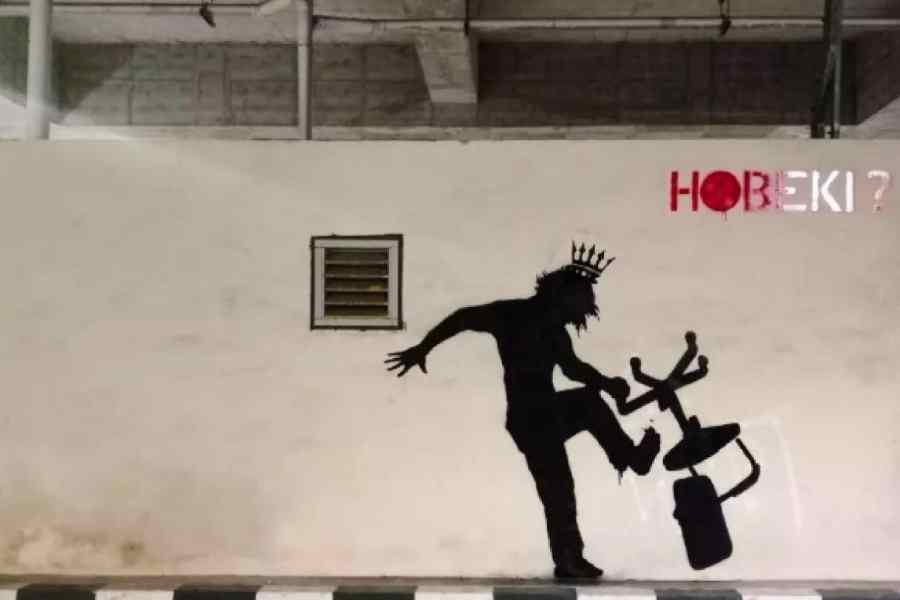In the early hours of August 6, the day after the fall of Bangladesh Prime Minister Sheikh Hasina, Subodh emerged — possibly for the first time with a crown on his head.
For those who have not been introduced, Subodh is a graffiti series, a man-message from the walls of Bangladesh. Its creator’s signature is HOBEKI with a question mark. Hobeki as in — will it happen? Hobeki, a question cradling a question, ki hobe or what will happen?
It is difficult to say when Subodh first appeared, but The Telegraph wrote about him in 2017 when Subodh appeared on the walls of Calcutta’s Presidency and Jadavpur universities.
The Bengali word subodh means good sense, fair intent. As an adjective, it can mean docile, obedient, decent.
Subodh of the graffiti has been a restless, conflicted figure, mostly on the run, sometimes behind bars, sometimes sitting, hand on his head, despondent. But the visual from August 6 on the Instagram handle hobeki_ was something else.
Subodh in a state of tandav. One arm flailing, hair floating, one leg raised in assault, some inches away from a swivel chair mid-air, upside down. The visual is most likely from the TSC (Teacher-Student Centre), Dhaka University, Bangladesh.
One comment on the handle’s timeline reads: “Mate, I still don’t know who you are… But I have forever believed HOBE! Subodh onek din paliye beriyechhe kintu ekhon shomoy amader pokkhe… Subodh has been on the run for long, but now time is on our side… Thank you for making me hope.”
The crowned Subodh may not be on the run for now, but he is jumping (social media) platforms. Sample these comments from the Facebook shares.
Faisal Arefin: “Whoever comes to power has to have subodh before anything else… Subodhi egiye niye jaabe ei shonar Bangladeshke.”
Yet another: “Subodh sthayi bhabe phire ashuk.” Meaning, may good sense return permanently.
Is Subodh then a representation of Bangladesh’s angry, frustrated and protesting students? It is difficult to say. At the time of the 2017 story, one interviewee from Bangladesh said Subodh’s form reminded him of Biswajit Das who was hacked to death in 2012 by members of the Bangladesh Chhatra League, the then ruling Awami League’s student body. They had mistaken him for someone from the Opposition group.
But what one can piece together from the visual clues is that Subodh had been stirring awake the past many weeks, Prometheus-like.
On August 1, Hobeki Graffiti Fans posted on Facebook an audio clip of a poem written by Shibbir Rahman and recited by Marufa Lisa. Titled “Subodh, tui kon morgue e aachhish… Which morgue are you in, Subodh”, it is more keening than poem, though. The visual showsSubodh hanging.
Not all the creations are by Hobeki, some are inspired. Mautasim Tasnim posted on August 2 an artwork that shows a moving procession, flags et al, with Subodh at the forefront. The accompanying message: “Subodh don’t run away. Tor paashe aaj kolorob.”
The last but one image is from July 18, a prequel to the August 6 visual. Angry Subodh, mid-assault, minus crown. The image is not of any wall but a shot of an artist’s table. And accompanying it is a tutorial by Hobeki. It reads: “I’ve included a graphic file to assist with your drawing. Use a sharp craft knife to cut precisely along the lines. Once you’ve finished cutting out the piece, position it on your desired surface. Hold the spray can about 1 foot away for optimal results to cover all the cut-out areas thoroughly and complete the process (sic).”
The accompanying hashtags: #hobeki #studentmovement2024 #bangladesh
Postscript: Morning after the siege of Dhaka. The most dominating visual perhaps for those outside Bangladesh is Sheikh Mujib’s statue either swarming with “students”, or hanging its bulldozer-pecked head.
That Hobeki is wise, never given to absolutes, never disengaging from the embrace of the question mark.











